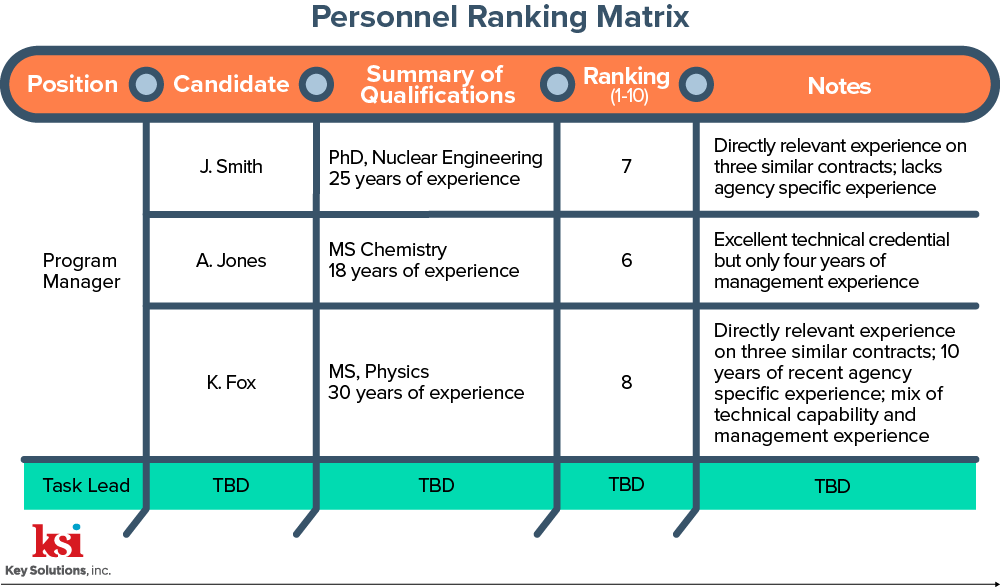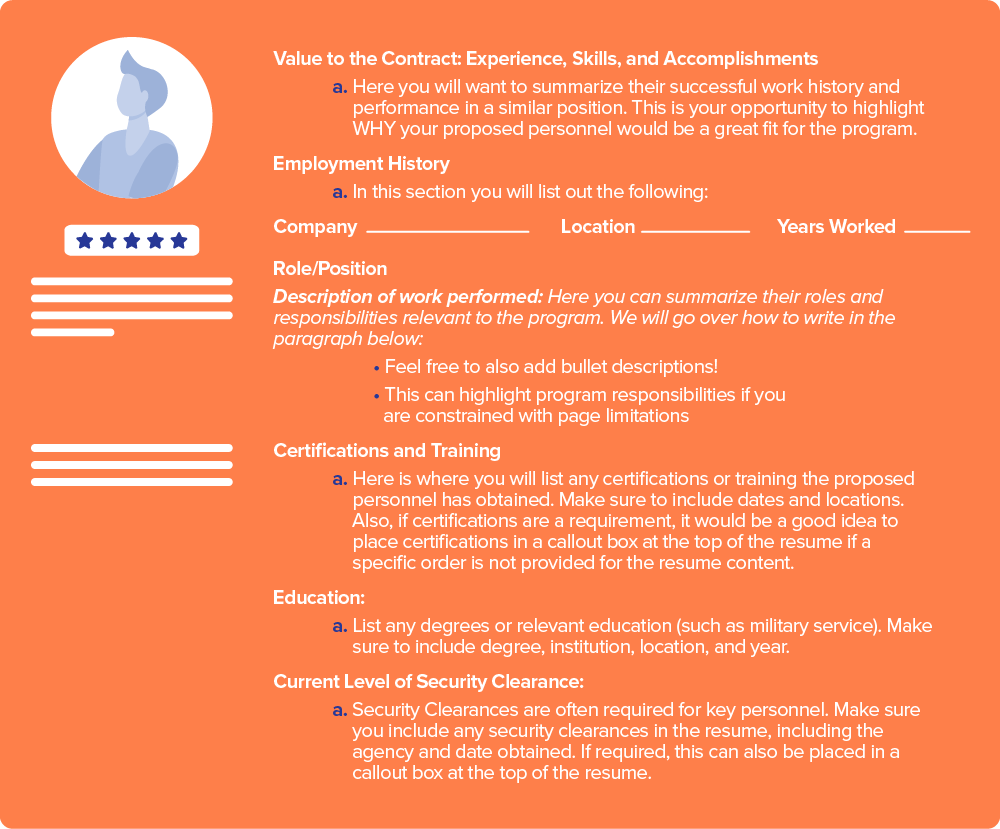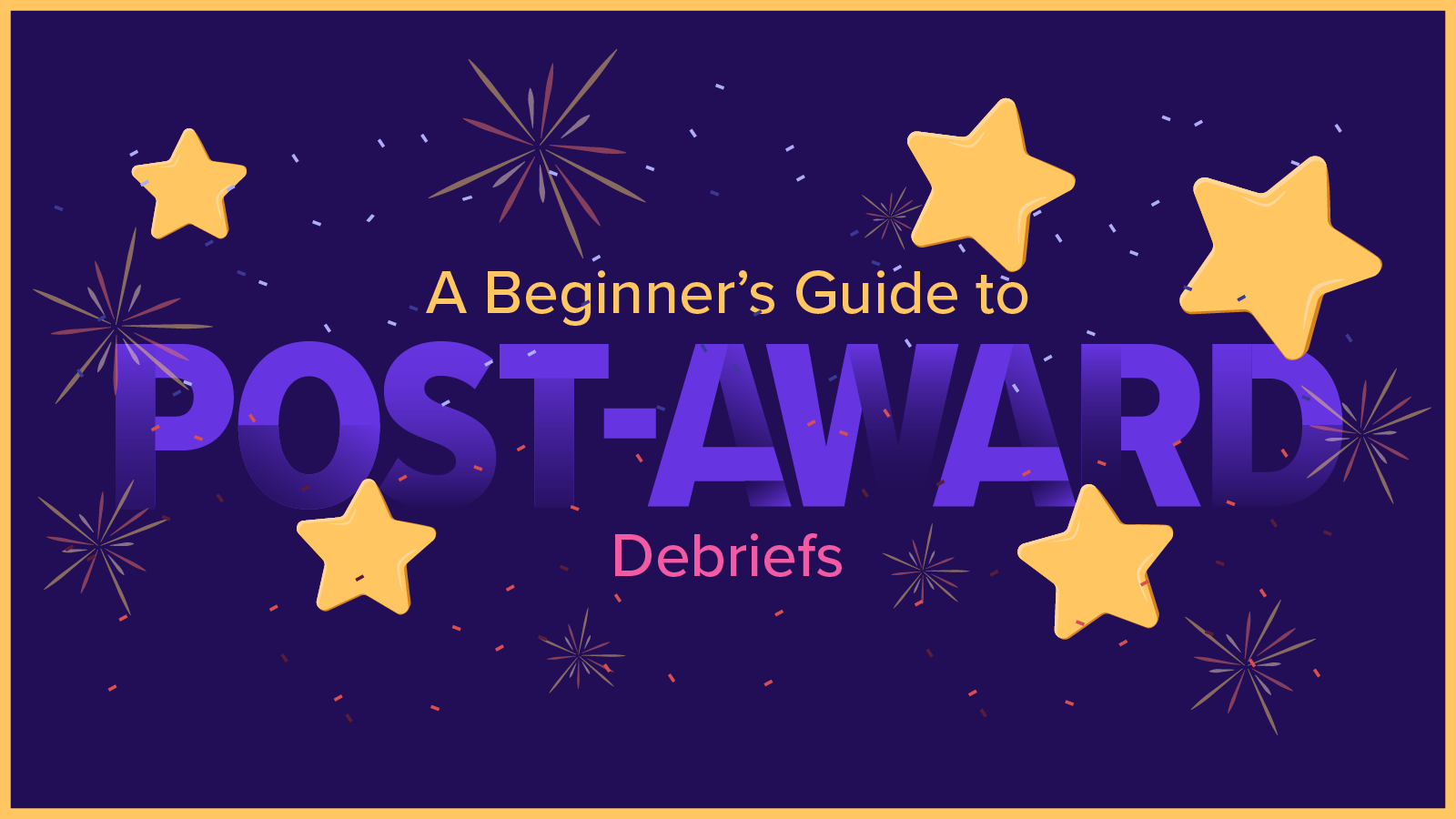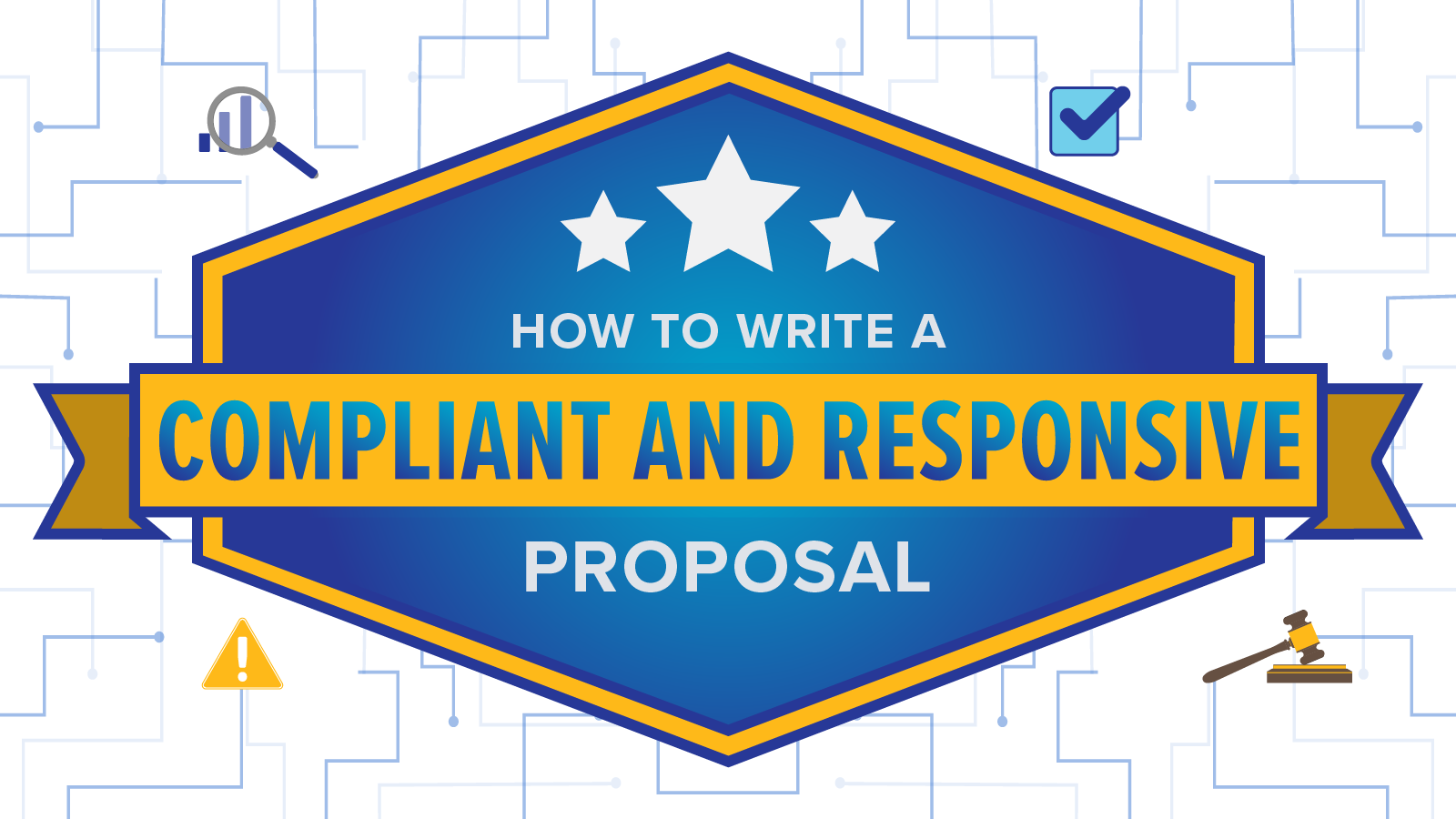
Individual accomplishments and experience have a chance to shine in today's competitive bid environment.
The industry is filled with incredibly bright and talented individuals, and I'm sure you've met more than a few. When finalizing your proposal, selecting the right key personnel is one of the best ways to demonstrate to your customer that your organization and solution meet all program requirements.
To ensure you are selecting the best key personnel for each proposal, you should:
- Follow the RFP requirements
- Choose individuals that have the most relevant and expansive work history
- Highlight their relevant accomplishments and proposed value to the program
After key personnel selection, you must ensure that the individual’s resume is properly formatted. To ensure that a resume holds value, it is important to highlight any relevant program responsibilities; feature any RFP requirements up-front, such as security clearances or certifications; and properly format descriptions in a concise and detailed fashion.
A resume can reflect an organization’s confidence in the proposed individual and is an opportunity to display individual accomplishments, successful work in a similar industry or agency, and a program's time or cost savings.
In this article, we will discuss how to help proposal teams select key personnel and create, revise, and format their resumes.
1. Follow the Request for Proposal (RFP) Requirements
The first step to ensuring you have selected the proper key personnel for a program is to follow the RFP requirements.
In most instances, an RFP will call out which specific roles they want you to fill. Whether it is a Program Manager, Transition Manager, Quality Manager, or Sales Engineer, each proposed candidate must match the qualifications and experience asked for in the RFP.
Ideally, the capture team will select key personnel in advance of an RFP opportunity, but it is a good idea to create a Personnel Ranking Matrix when deciding which candidate is the best to propose. The matrix can help the team organize and identify the best candidate for a position. It should include important program qualifications, such as the summary of qualifications, and any relevant experience on similar contracts.
Please see below for an example of a Personnel Ranking Matrix from the KSI Advantage™ Capture & Proposal Guide.

Another helpful KSI Advantage tool for selecting key personnel is the Personnel Tracking Matrix. This matrix can help you track the process of resume development for each color review. The Personnel Tracking Matrix will help organize the team and can keep the Program Manager up to date on the resume development process.
Both matrixes help organize the team during a stressful writing process and can help ensure that you don’t lose any evaluation points when selecting the best key personnel for the program.
![]()
It is also important to gather the necessary information to tailor the candidate’s resume to the RFP requirements. One useful tool to gather data on key personnel is to conduct a Key Personnel Interview Questionnaire. This is a great opportunity to speak to the individual and get input on factual experience and information that can be a benefit to the proposal response.
Ask the candidate for any information or gaps that their baseline resume didn’t provide. Attempt to find specific metrics, statistics, industry achievements, dollars saved, accomplishments, or any customer accommodations. Ask them to summarize the experience that qualifies them to take on this role for the project.
Conducting a key personnel interview is a great opportunity to obtain language on the experience and qualifications that an individual can provide to a program. Here are some examples of role-specific questions you can ask:
- Describe your experience providing competent leadership and responsible program direction through successful project transitioning.
- Summarize your experience using data from project management tools.
- Describe your experience simultaneously planning and managing the transition of highly technical projects and directing the completion of tasks within estimated time frames and budget constraints.
- Describe your experience in communicating—both written and orally—with all levels of management and government representatives such as the Contracting Officer (CO/KO), Contracting Officer’s Representative (COR), and/or Contracting Officer’s Technical Representative (COTR).
Interview questions can cover a variety of topics depending on the role being proposed. Reaching out and speaking directly to the individual can help the resume lead highlight relevant information and ensure that an evaluator immediately notices their value and unique ability to perform on the contract.
Another helpful tool that will help you gather information on key personnel is the Personnel SOW checklist. This is your opportunity to list out each section in the Scope of Work and check if your proposed key personnel match the requirements and have experience handling a similar workload. The checklist should include all SOW sections and a column that describes the individual’s experience, timeframe, and work provided on projects with similar scope and complexity.
All these tools will be extremely helpful for tracking RFP requirements and can lay the groundwork to ensure that you have selected the proper key personnel. The more information a resume lead has to work with, the higher the chance that they will be able to create a compelling narrative in each resume that describes the individual’s ability to perform on an upcoming contract.
Now that you have conducted an interview with the personnel, charted each of their qualifications to the RFP requirements, and formed their value proposition to the contract, you can begin to flesh out and format the resumes.
2. Formation of the Resume
After receiving the baseline resume and speaking to the proposed individual to fill any gaps, it is time to get started on the production of the key personnel resumes.
Before you begin to write the resume and fill the response with content you’ve obtained, it is crucial to establish a specified resume template that reflects any key personnel requirements found in the RFP. If the RFP doesn’t provide a required format/template for resumes, to ensure that you are delivering a quality key personnel resume, develop a standard format and keep the same format throughout each resume submission.
Once again, you will want to follow any RFP requirements and put any required information upfront in a callout box (i.e., Security Clearances, certifications, etc.), but we will speak more on resume writing later. A few common resume formats include the Table Format, the Single Column Format, and the Left Scholar's Margin.
The structure illustrated in the graphic below can help you develop an organized resume if no structure is stipulated by the RFP.

As we’ve discussed, the resume template should be developed based on the RFP requirements, but adopting a section based on an individual’s work experience and explaining the potential positive impact they can have on a program should increase the Government’s awareness of your ability to successfully execute all program requirements.
Forming your resume based on RFP requirements and gathering valuable information on each candidate will result in better organization and leave you with more time to focus on the part that makes a difference: writing the resume.
3. Writing the Resume
Once you’ve received confirmation of each key personnel, conducted interviews to fill any gaps, and decided on a standardized template that will reflect your confidence in the proposed personnel, it is time to start writing the content of the resume.
You should highlight each individual’s ability to exceed program requirements and their value to the contract through your description of their experience, skills, and accomplishments.
Please note, while the sections below can help you form a compliant and compelling resume, it is smart to include a summary of qualifications at the top of the resume that maps relevant skills and qualifications to the requirements of the labor category.
Continue reading below to find out how to explain and emphasize your key personnel’s value to the proposed program.
1. Value to Contract
Be sure to include any relevant experience within a similar agency or program, dollars saved, successful performance with similar responsibilities, or impressive metrics.
This is your opportunity to explain what the individual has achieved in the past and how it can be applied to the proposed program. This can often be the most difficult part about writing a resume; you want to explain WHY this individual is advantageous to the customer, and oftentimes, this requires the resume lead to acquire a new language that wasn’t provided in the baseline resume.
Ask yourself why the customer would want to work with the key personnel. Explain what they can bring to the table and describe for the customer how this is the only individual that can successfully perform the work.
2. Experience, Skills, and Accomplishments
After you highlight an individual’s value, next you should summarize their industry experience and how they can use their knowledge in a way that will lead to a successful program.
You can highlight their daily activities and responsibilities when communicating with the customer and internal team or their proven ability to deliver program requirements within a program with similar size, scope, and complexity. This is your opportunity to pull job responsibilities from past positions and highlight their industry knowledge.
This would also be a good opportunity to summarize relevant program accomplishments, such as successfully transitioning a team of 90+ employees, or displaying relevant awards, such as Federal Sales Employee of the Quarter. Either way, this section can highlight an individual’s excess of industry experience and how they continuously improve industry knowledge throughout their accomplished career.
3. Employment History
When writing this section, follow the format we previously discussed.
When describing past job qualifications, make sure that you are writing in complete sentences and that you follow the same grammatical tense. You will want to highlight program responsibilities and only discuss tasks that are relevant to the proposed position. Make sure that each position follows the past one; you don’t want to have any gap years between positions. Be sure to include metrics and proof points throughout the employment history section as well.
Although key personnel resumes can be put on the backburner of a project, adding a summary or description of their value, experience, skills, and accomplishments can become a part of your solution narrative. Make sure you highlight proof points of achievements and weave SOW keywords throughout your resume response.
Since these are the individuals that your customer will be working with daily, including the value of your proposed key personnel is critical. This will be an effective first step to instilling confidence in the customer know you can meet and exceed program expectations.
Conclusion
Key personnel resumes are an opportunity to reinforce to the customer why they should select your team.
A proposal team can do this by selecting the right key personnel and justifying their selection by explaining their value to the program—including metrics that reflect a successful work history. You can ensure the proper selection of key personnel by following RFP requirements and highlighting an individual’s relevant work history, accomplishments, and qualifications.
You must properly format the resumes to ensure they can be easily evaluated against any RFP requirements, as well as demonstrate the value that the candidates will bring to the program. Expand your knowledge of their program and needs by explaining why an individual is a perfect fit for their program and the value they can provide to the customer.
Featuring high-quality key personnel for a program effectively can become a significant advantage when bidding on an opportunity, particularly when key personnel holds significant weight in the evaluation criteria.







